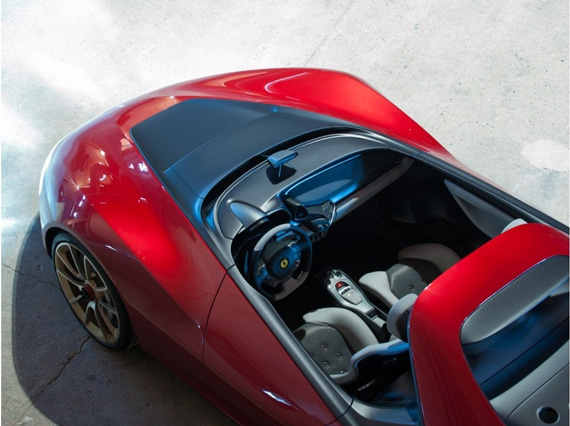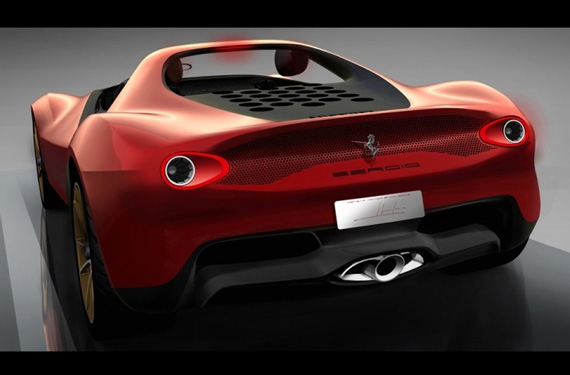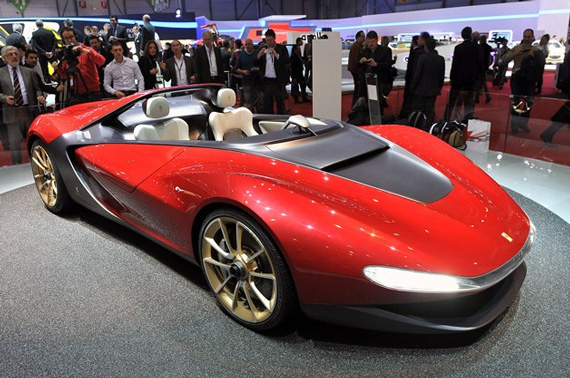
One of the highlights of this year's Geneva Auto Show is the 2013 Ferrari Pininfarina Sergio Concept, a design exercise built to pay tribute to the to late Sergio Pininfarina, who passed away last year. The 2013 Pininfarina Sergio is a realistic concept that could easily be produced in limited series, It is only 1,140 m high, 1,94 m wide, 4,55 m long and weighs 1280 kg. It offers real sports performance, with acceleration from 0-100 km/h estimated at below 3.4 seconds and a top speed of around 320 km. Click for YouTube.
Ferrari Sergio Concept Car
The Ferrari Sergio Concept is a windscreen-less open two-seater sports car (Barchetta). Its mechanicals are those of a Ferrari 458 Spider. Thus the concept car has the same wheelbase and tracks and is also powered by a 4.5L V8, mated to a seven-speed sequential gear box.
The Pininfarina Style Centre developed the shape of the Sergio making full use of the Grugliasco wind tunnel to optimize its aerodynamics. Its body, made from carbon, weighs about 10% (150 kg.) less than to the original 458 Spider body in aluminum, but exceeds its torsional stiffness.
There is no windshield. An aerodynamic deflector in front of the cockpit creates a virtual windscreen through the deviation of the air flow, protecting the passengers from turbulence. The roll bar, designed as a wing surface, is perfectly tuned to the evolution of the flow coming from the front, adding a further down force effect.
Looking at the tantalizing Pininfarina Sergio Concept I remembered that between 1996 and 1999, Renault produced a limited number of small roadsters, called the Sport Spider. It also had butterfly doors and no windscreen. Like with today’s Pininfarina Sergio, an aerodynamic induced airflow had to protect driver and passenger at higher speeds from the wind hitting them too hard in their face. It is purely coincidence, but that time a young woman called, Anne Asensio, worked at Renault, where among other projects she conceived the Scenic Concept. Later she was hired by General Motors. Today Anne Asensio is employed by Dassault Systemes, a French engineering firm that develops design and manufacturing systems for the aviation and automotive industry. Dassault Systemes as a consultant to the Pininfarina Style Centre, was also involved in the development of the Pininfarina Sergio Concept. (watch the video by clicking on lead photo).
Anne Asensio is responsible at Dassault Systemes for its Design Experience Strategy, providing Design Experience communities and solutions for enterprises, as well as design studios and individual designers. This goes far beyond the automotive industry and includes sectors like architecture, life sciences, consumer goods etc.
Concept Car Round Up
In addition to the Sergio, shown last week at Geneva, the following are concept cars as shown at the recent Detroit Motor show and the Festival International d’Automobile in Paris. We’d like to know what you think. Are these dream cars relevant, exciting, full of new ideas or could they be replaced with a stunning show of automotive virtual reality?
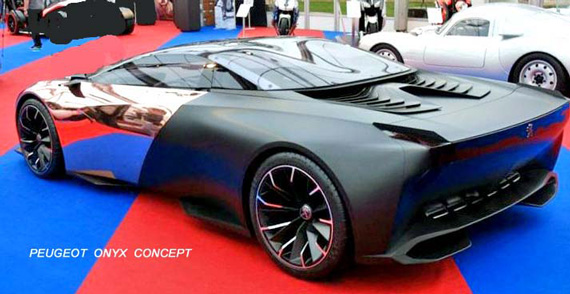
Peugeot Onyx concepts. Peugeots Onyx concept car was already shown at the 2012 Mondial de l’Auto last October. The rear of the body and the nose are made from carbon and finished in matt black. On both sides of the font part, polished but otherwise untreated copper is used. The transparent double-bubble roof reminds one of that of the Peugeot RCZ coupé. Its material is PolyMethylMethAcrylate, a shatter-resistant plastic. Even if this ultra-low machine looks rather far out, it technical specification is absolutely state-of-the art. The chassis, designed by Peugeot Sport, is constructed from monolithic carbon and equipped with the 3.7-litre V8 hybrid HDi FAP engine, developed for Peugeot's Le Mans program.
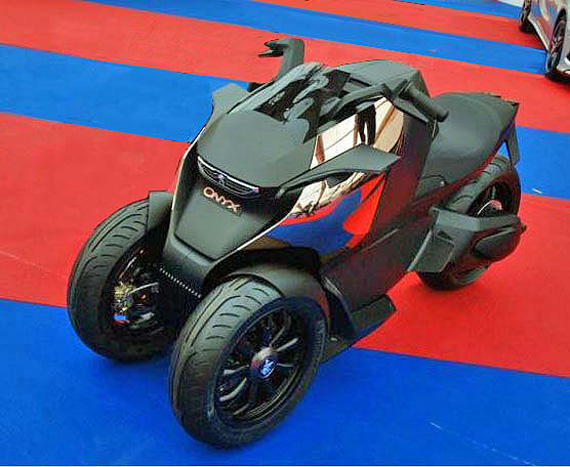
Peugeot Onyx Scooter. For the first time the organizers of Festival International d’Automobile allowed motorbikes and scooters at their exhibition. Peugeot, a well-known manufacturer of scooters, presented its Onyx Concept Scooter. Finished in the same way as their Onyx concept car with a matt black carbon and shiny copper body, it has dual front wheels similar to the Piaggio MP3. The Onyx concept Scooter is also a hybrid. It has a 400 cc engine and an electric motor, which together provide up to 60 bhp (45 kw) and 58Nm (42 pound-feet) of torque. According to Peugeot it can do 117.6 miles per gallon and has the potential to reach 150 km/h.
Both Onyx concepts were developed by Peugeot Design Lab, launched last June. The purpose of the Peugeot Design Lab is to develop strong and coherent brand strategies specifically to reinforce the identity, values and codes of external customers. Its main assignment is the design of non-automotive products, services and experiences. Peugeot Design Lab has access to design trends in Paris, Shanghai and Sao Paolo.
A few manufacturers, among them Peugeot, offer a matt black or matt grey finish on some of their models. But in France this is not (yet) very popular. Apart from its price supplement, the main problem is: you have to wash your car by hand, as most automatic car wash installations use a detergent that makes the paint shine.
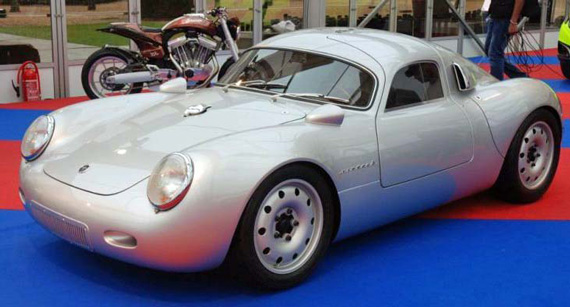
Vintech P550 Tribute. Vintech is part of a French company named Groupe D3, based àt Guyancourt. Groupe D3 consist of 4 enterprises, each with it own specialty: ADD, Artware Concept, d3 l’atelier, Numero Design. Their activities cover industrial product design, 3D production, research and development of colors and materials, engineering and studies for production of small scale and industrial moldings. The Porsche-like Vintech P550 Tribute was earlier presented in the USA; it is in fact not a concept for a car but an interesting and technical outstanding eye catcher to prove what Vintech and Groupe D3 are capable of. Pure Industrial PR.
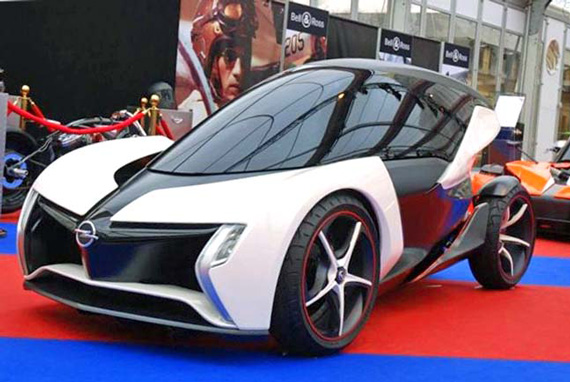
Opel RAK-e. It was earlier presented at Frankfort in 2012. The name RAK-e recalls the rocket-powered RAK 2 record car which Fritz von Opel produced in 1928. The RAK-e is a narrow-tracked, canopy-roofed, electric two-seater urban / fun car concept. It is just 3 meters long and 119 cm (46.9 inches) high. With only 380 kg (838 lbs.) the RAK-e weighs about one third of a modern small car. The electric motor will provide 10.5 kW/14 continuously. Using its peak power of 36.5 kW, the vehicle can reach 120 km/h (75 mph) in less than 13 seconds. After charging the battery for three hours, the experimental vehicle has traveled up to 100 km (61 miles). Over an annual 10,000 km (6,214 miles) the RAK-e's energy consumption would be 525 kWh. This could be supplied by a five square-meter, 500-Watt solar panel mounted on the roof of the garage. The arrangement of tandem seats is reminiscent of those in a glider plane, with one in front of the other. The cockpit is fully enclosed, but has no air conditioning. For cooling the interior one must slightly raise the canopy, while seat heaters provide warmth. Instrumentation consists of a single display showing speed, eco gauge and battery range indicator, a smart phone can provide navigation and can remotely control functions, such as the seat heaters, while the car is charging. At the moment General Motors' German Opel division is seriously researching the commercial potential of this machine, within a price range between 10,000 and 13,000 Euro, comparable with that of the Opel Agila. According to project engineer Stefan Gloger, the RAK-e is technically ready. The challenge now is to find out if it can be sold in sufficient numbers to warrant the investments for its tooling.
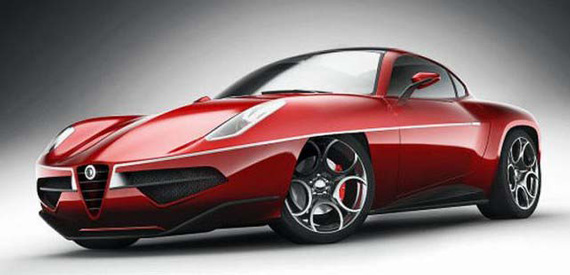
Touring Disco Volante Concept Car During the early 50s, Alfa Romeo and Carrozzeria Touring in Milan, constructed three cars that became known as the Disco Volantes (Flying Saucers), but officially as the 1900 C52. It was a research project to test technologies that could be adapted for racing. The aluminum bodies were hand-built on a tubular space frame (a Touring superlegera specialty) and their shape wind tunnel tested. Alfa Romeo provided tuned 1900 engines (1997 cc) producing 158 bhp (118 kW), that gave the Disco’s a top speed of 220 kilometers per hour (140 mph). To commemorate this, Touring unveiled a new Touring Disco Volante Concept using the platform and powertrain of the Alfa Romeo 8C Competizione. This has a longitudinally mounted 4.7-liter V8 engine delivering 443 horsepower and 353 lb.-ft. of torque, coupled to a six-speed paddle-shift gearbox and driving the rear wheels through a limited-slip differential. Touring’s 2012 Disco Volante concept is a mixture of modern technology with a sniff of retro styling. The concept has sculptured fenders and a split grille just as the original versions. Its body is made up from hand-formed aluminum panels and carbon fiber elements. The concept is in fact not a real concept but a prototype. Because Touring is willing to build a similar body for anyone on condition that they can provide an Alfa Romeo 8C Competizione as a donor car and is willing to pay their price.
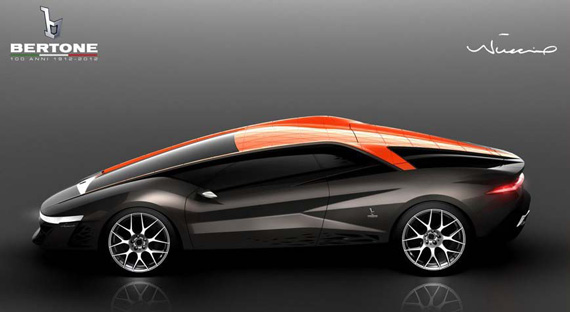
Bertone Nuccio concept. This design study was developed by Gruppo Bertone to celebrate the 100 years of the company. It is named after Giuseppe Bertone, also known as Nuccio, the man who made the name Bertone world famous as one of the leading Italian coach building and design firms. The grey metallic body has an orange roof, the same color orange as the labels on the bottles of Veuve Clicquot, Nuccio’s favorite champagne. Under the extremely low and sculptured bodywork of this mid engined show car hides 4.3-liter V8 Ferrari powerplant, developing 480 bhp. The Nuccio concept certainly reflects the Bertone style of the striking and timeless one-box designs that made the reputation of company during the 1970s. The Nuccio is mainly a prestige project for the Groupo Bertone and has been exhibited in Geneva, Beijing, Turin, Laguna Seca, Florence and finally at the Festival International d’Automobile in Paris. It is rumored that Bertone will eventually sell this car to a worthy and wealthy collector.
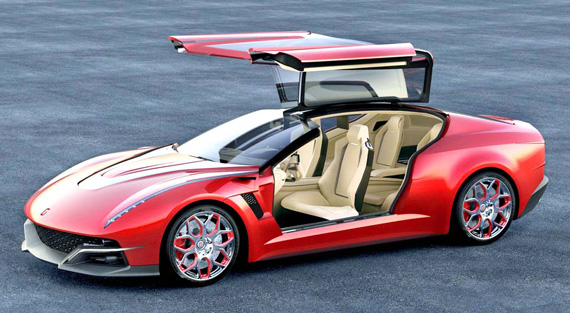
Italdesign Giugiaro Brivido concept. Brivido means 'Thrill'. It is a hybrid four-seat prototype, designed in collaboration with the Volkswagen Group. With a 3.0-liter engine, producing 360HP (265 kW) and an 8-speed automatic transmission it is capable of reaching 100 km/h in 5.8 seconds and a maximum speed of 275 km/h. No details are given regarding the hybrid side of the powertrain. The Brivido is a genuine four seater and offers space and visibility, especially for the rear passengers, but it is only 4.98 meters long. The body of the Brivido concept, finished in Xirallic pearl lustre red, is made from aluminum, carbon fiber, and glass. The windscreen, roof, rear window, and large door windows form a glass dome over the passenger compartment. The interior was developed in collaboration between Italdesign Giugiaro and the Volkswagen Group Electronics Research Lab. There are interactive displays including an iPad, integrated on the passenger side of the dashboard. The tablet allows navigation, and online access to media. The passenger can dock it for use or stow it away in the dashboard. Italdesign Giugiaro also patented an innovative steering column design. At the top of the steering column are two monitors showing images from side and rear cameras. All main controls are housed on two touch-sensitive panels on the spokes of the steering wheel. ‘The Brivido is not a dream car’, explained Giorgetto Giugiaro. ‘This is not an object which is destined to remain an unachievable dream. My intention has always been to design something which is close to reality’.
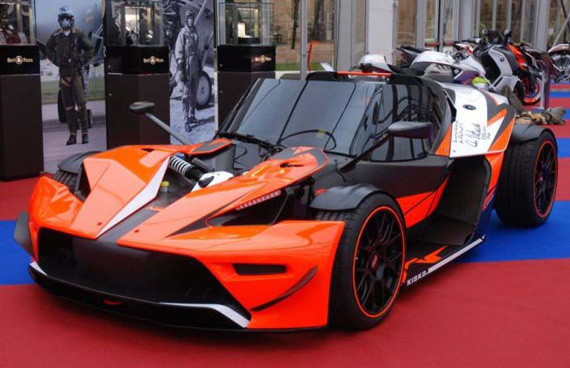
KTM X-BOW 7.25. It was the surprise of the Festival International d’Automobile exposition. The KTM X-BOW 7.25 is a research prototype developed by the Austrian design group Kiska. The main external difference with the actual model of this street legal bi-posto racing car, is the improved comfort for driver and passenger thanks to a high windscreen and windows in the doors. The designation 7.25. refers to the record lap time of 7’25’’72 registered past November by racing driver Christopher Haase with a KTM X-Bow on the Nürburgring.
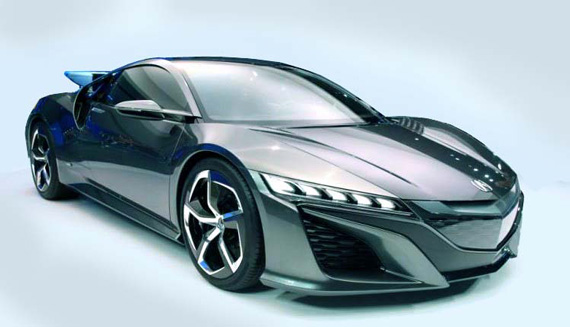
Acura NSX Concept II. Already exhibited at the 2012 Detroit Auto Show, Honda’s premium brand returned the NSX in January 2013, with subtle styling modifications and a complete interior. Mechanically the concept remains unchanged, with a mid-mounted naturally-aspirated V6 engine and an electric motor in each wheel, providing all-wheel-drive. Power figures not yet been given, but if the V6 is the new engine announced late last year, one can expect at least 231kW - plus whatever boost the electric motors will add. The design of the interior gives an idea of what the car’s cockpit will look like when the new NSX finally goes into production. It is equipped with a large centre console and a large screen in place of the traditional instruments behind the steering wheel. The finish is all-premium, with a mix of leather and suede trim.
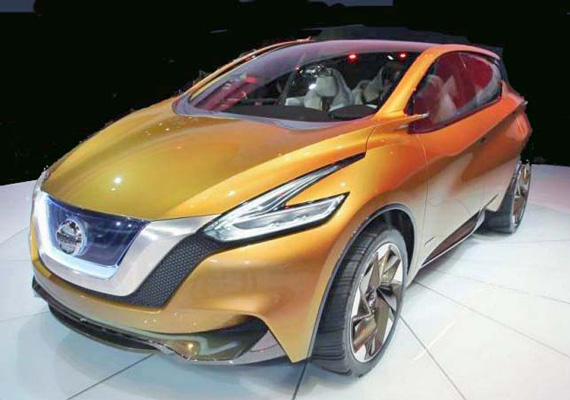
Nissan Resonance Concept. It made its first appearance at the 2013 Detroit Auto Show. While seen as a concept of global relevance, Resonance was created by Nissan Design America, San Diego, CA, under the direction of Shiro Nakamura, senior vice president and chief creative officer of Nissan Motor Co. It is believed to contain the ingredients of the next-generation Nissan Murano cross-over to be produced in Mississippi. The Resonance is 4.84 m. long, 1.99 m. wide, 1.73 m. high and has a the wheelbase of 2.88 m. The concept car has a hybrid driveline with a 2.5 liter petrol engine, an electro motor, a lithium-ion battery and a new type CVT automatic gearbox. The use of thin, steeply raked A-pillars, a large full-length glass panel and flowing D-pillar design, creates the illusion of a 'floating' roof. For the interior, the designers imagined what the future of first-class space travel might be: Welcoming yet exclusive and high-tech yet premium. An advanced instrument panel floats on a generous console giving the driver access to infotainment and communication media.
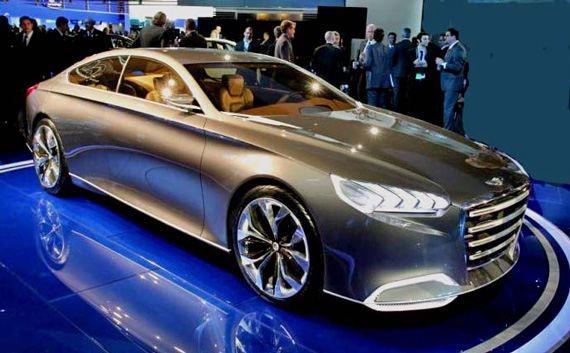
Hyundai HCD-14 Genesis Concept. The talented German designer Peter Schreyer, whose attractively-styled range of Kia models gave that Korean manufacturer entry to the word markets, is now also responsible for the design of the cars of Kia’s mother Hyundai. At the 2013 Detroit Auto Show 2013, the Schreyer designed HCD-14 Genesis Concept, gave an indication where Hyundai’s 'premium vehicles' are headed. With a sharp-edged style and suicide doors, inside the concept sedan has a control layout that foregoes the traditional knobs and buttons. According to Hyundai it includes eye tracking and 3D hand gesture recognition, accurate enough to control navigation, infotainment, audio and one's smart phone. Optical recognition verifies the physiognomy of the driver before allowing him to start the engine. The HCD-14 Genesis Concept is powered by a 5.0-liter Hyundai Tau V8 engine. Hyundai announced that there are two vehicles in their pipeline following this concept's design, with the second containing even more advanced technology.
Looking at these concept cars, it’s important to realize that the market for new automobiles has become a global affair. In most parts of what was once called the developing world, the purchasing power of a fast growing middle classes is rapidly increasing. Some economic experts expect that soon even Russia will become a more important market than the U.S. or the Eurozone. But it is a fact that new economies offer promising and tempting opportunities for the carmakers. All this has of course direct consequences for the design and styling of their cars, because manufacturers have no longer only to consider the tastes and requirements of North Americans and Europeans but also those of potential customers in Russia, China, India, other Asian states, and various countries in South America and Africa.
Read what top designers think…
